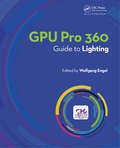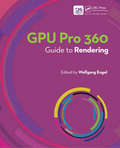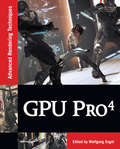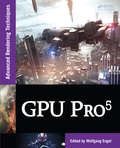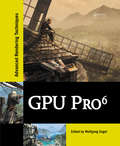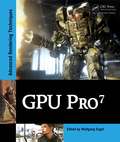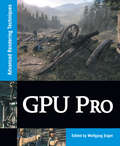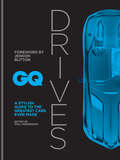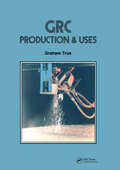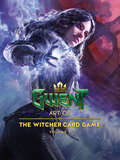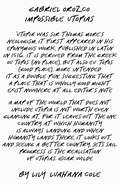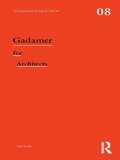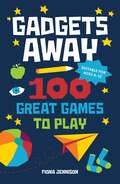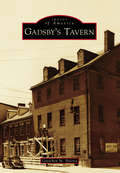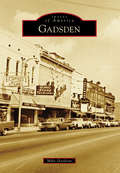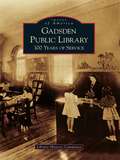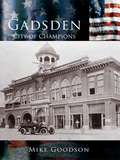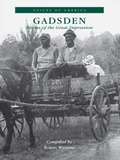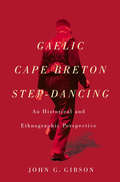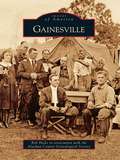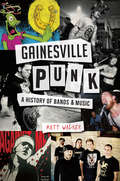- Table View
- List View
GPU Pro 360 Guide to Lighting
by Wolfgang EngelWolfgang Engel’s GPU Pro 360 Guide to Lighting gathers all the cutting-edge information from his previous seven GPU Pro volumes into a convenient single source anthology on lighting. This volume is complete with 24 articles by leading programmers that describes rendering techniques of global illumination effects suited for direct rendering applications in real time. GPU Pro 360 Guide to Lighting is comprised of ready-to-use ideas and efficient procedures that can help solve many computer graphics programming challenges that may arise. <P><P>Key Features: <li>Presents tips and tricks on real-time rendering of special effects and visualization data on common consumer software platforms such as PCs, video consoles, and mobile devices <li>Covers specific challenges involved in creating games on various platforms <li>Explores the latest developments in the rapidly evolving field of real-time rendering <li>Takes a practical approach that helps graphics programmers solve their daily challenges
GPU Pro 360 Guide to Rendering
by Wolfgang EngelWolfgang Engel’s GPU Pro 360 Guide to Rendering gathers all the cutting-edge information from his previous seven GPU Pro volumes into a convenient single source anthology that covers real-time rendering. This volume is complete with 32 articles by leading programmers that focus on the ability of graphics processing units to process and generate rendering in exciting ways. GPU Pro 360 Guide to Rendering is comprised of ready-to-use ideas and efficient procedures that can help solve many rendering programming challenges that may arise. Key Features: Presents tips and tricks on real-time rendering of special effects and visualization data on common consumer software platforms such as PCs, video consoles, and mobile devices Covers specific challenges involved in creating games on various platforms Explores the latest developments in the rapidly evolving field of real-time rendering Takes a practical approach that helps graphics programmers solve their daily challenges
GPU Pro 4: Advanced Rendering Techniques
by Wolfgang EngelGPU Pro4: Advanced Rendering Techniques presents ready-to-use ideas and procedures that can help solve many of your day-to-day graphics programming challenges. Focusing on interactive media and games, the book covers up-to-date methods for producing real-time graphics.Section editors Wolfgang Engel, Christopher Oat, Carsten Dachsbacher, Michal Vali
GPU Pro 5: Advanced Rendering Techniques
by Wolfgang EngelIn GPU Pro5: Advanced Rendering Techniques, section editors Wolfgang Engel, Christopher Oat, Carsten Dachsbacher, Michal Valient, Wessam Bahnassi, and Marius Bjorge have once again assembled a high-quality collection of cutting-edge techniques for advanced graphics processing unit (GPU) programming. Divided into six sections, the book covers render
GPU Pro 6: Advanced Rendering Techniques
by Wolfgang EngelThe latest edition of this bestselling game development reference offers proven tips and techniques for the real-time rendering of special effects and visualization data that are useful for beginners and seasoned game and graphics programmers alike.Exploring recent developments in the rapidly evolving field of real-time rendering, GPU Pro6: Advance
GPU Pro 7: Advanced Rendering Techniques
by Wolfgang EngelThe latest edition of this bestselling game development reference offers proven tips and techniques for the real-time rendering of special effects and visualization data that are useful for beginners and seasoned game and graphics programmers alike.Exploring recent developments in the rapidly evolving field of real-time rendering, GPU Pro 7: Advanc
GPU Pro: Advanced Rendering Techniques
by Wolfgang EngelThis book covers essential tools and techniques for programming the graphics processing unit. Brought to you by Wolfgang Engel and the same team of editors who made the ShaderX series a success, this volume covers advanced rendering techniques, engine design, GPGPU techniques, related mathematical techniques, and game postmortems. A special emphasi
GQ Drives: A Stylish Guide to the Greatest Cars Ever Made
by Paul HendersonForeword by Formula 1 world champion Jenson Button.From the magazine synonymous with style comes the ultimate guide to the greatest cars the world has ever seen.With imagery from the finest motoring photographers, plus British GQ's knowledgeable in-depth reports, the cars in this book represent the pinnacle of driving style and performance. From design classics to the very latest machines, GQ Drives is an indispensable handbook of automotive excellence.Over 50 incredible drives, including: Ferrari FXX Mercedes-AMG Project One Lamborghini Huracán Aston Martin One-77 Jaguar E-Type Chevrolet Corvette ZO6 Pininfarina Battista Rolls-Royce Phantom Drophead Coupé And many more...
GQ Drives: A Stylish Guide to the Greatest Cars Ever Made
by Paul HendersonForeword by Formula 1 world champion Jenson Button.From the magazine synonymous with style comes the ultimate guide to the greatest cars the world has ever seen.With imagery from the finest motoring photographers, plus British GQ's knowledgeable in-depth reports, the cars in this book represent the pinnacle of driving style and performance. From design classics to the very latest machines, GQ Drives is an indispensable handbook of automotive excellence.Over 50 incredible drives, including: Ferrari FXX Mercedes-AMG Project One Lamborghini Huracán Aston Martin One-77 Jaguar E-Type Chevrolet Corvette ZO6 Pininfarina Battista Rolls-Royce Phantom Drophead Coupé And many more...
GRAFF COLOR MASTER: Freestyle Color Techniques for GRAFFITI Art
by Scape Martinez"Color communicates because color is powerful, & powerful color is more powerful still." --Scape Martinez In this hot-off-the-streets book, Scape Martinez shows you how to use color to bring beauty, meaning and life to graffiti art. To shout, shock and sing. To push the boundaries of art and communicate in a way that letter structure alone cannot. By example, you'll learn how to connect your own color choices in a meaningful way, making your art both deeply personal and highly effective. Check out Scape's improvisational creative process as he creates 12 works (his "personal cave paintings") on concrete and canvas, step by step, from concept to completion. Instruction and exercises help you choose the colors that work for you and your artwork, find your distinct voice, and keep it real. Dig into Scape's bag of tricks for creating a site-specific piece, mixing conventional can techniques with traditional acrylic painting skills, exploring transparent letters and letter abstraction, working with monochromatic color schemes, turning letters inside out, and lots more. It's time to let go of old graffiti truths, like the idea of mandatory black outline and static fill-ins. The new aesthetic urges you to take creative risks. Combine expressive letter styles with wild and intense color schemes that transform, roll and change throughout your piece. Improvise on the spot. Drive it to the next level!
GRC (Glass Fibre Reinforced Cement): Production and uses
by Graham TrueThis E. & F. N. Spon title is now distributed by Routledge in the US and Canada This title available in eBook format. Click here for more information.Visit our eBookstore at: www.ebookstore.tandf.co.uk.
GUÍA PARA EL CINE DE STEPHEN KING (Con las entrevistas a Mick Garris y Dee Wallace)
by Marcello Gagliani Caputo Traducción de Julio César Navarro VillegasUn viaje por las cintas y las series de televisión tomadas de las novelas y los relatos de Stephen King. De "Carrie" a "La cúpula", historia, génesis, documentos y curiosidades. Con las entrevistas a Mick Garris y Dee Wallace. Pocos escritores han logrado condicionar el cine como Stephen King, desde los años '70 hasta hoy, casi todas sus novelas han sido llevadas a la pantalla grande o a la televisión, síntoma de la extraordiaria capacidad del autor estadounidense para contar historias construidas justamente para transformarse en imágenes. Directores como Brian De Palma, Stanley Kubrick, Rob Reiner y Frank Darabont, sólo por citar algunos, se han popularizado con la transposición de un libro de King, obteniendo en algunos casos un éxito estrepitoso, en otros dando un giro radical a la propia carrera. El primero, en 1976, fue De Palma con "Carrie", su segundo largometraje, obteniendo el pasaporte para la gloria, seguido al poco tiempo por Tobe Hooper que llevó a la tv "La hora del vampiro" (1978) y sobre todo Stanley Kubrick y "El resplandor" (1980), motivo de infinitas polémicas entre el director y King, quien se ha declarado contrario a la relectura cinematográfica de su novela. Partiendo de estas bases, pero yendo mucho más allá, el libro recorre las etapas fundamentales que han hecho del autor estadounidense uno de los más "disfrutados" del cine, pero que también lo han visto involucrarse directamente (suya es la dirección de "Ocho días de terror" así como muchos de los guiones de otras cintas). Con un prefacio de Stefano Pastor ("Il giocattolo" y "Figlio che odiano le madri", de Fazi editore), desde la filmografía completa y embellecido con las entrevistas a Mick Garris ("La danza de la muerte", "El resplandor" para la tv, "Montando la bala" y otras cintas) y a la protagonista de "Cujo" Dee Wallace, este volumen narra la génesis de todas las películas (o s
GWENT: Art of The Witcher Card Game Volume 2
by Pawel Burza Ryan Bowd Alicja ZapalskaDiscover cards from all GWENT expansions in this full-color, beautifully laid out hardcover art book!GWENT: Art of The Witcher Card Game returns with Volume 2!Presented by Dark Horse, this glorious hardbound collection takes you on a journey through the game&’s eight expansions, featuring a trove of meticulously crafted cards that players across the realm have used to wage war against their opponents. This celebration of art is also a celebration of GWENT&’s place as a unique, memorable, and beloved part of The Witcher world, so enjoy your adventure through every page and every card within!
Gabriel Orozco: Impossible Utopias
by Lily Luahana Cole"Impossible Utopias is an original and elegantly-written meditation on the political potential of Gabriel Orozco's subtle body of work. Starting out from a close reading of Observatory House, a lesser-known work by the artist that also doubles as his holiday home, Lily Cole develops a persuasive account of the momentary utopias that are opened up by Orozco's playful experiments with everyday reality. In so doing, Cole also contributes to an urgent project to reassert the impossible possibility of utopian thought in and for the twenty-first century." --Luke Skrebowski, University Lecturer in the History of Art, University of Cambridge
Gadamer for Architects (Thinkers for Architects)
by Paul KidderProviding a concise and accessible introduction to the work of the celebrated twentieth century German philosopher, Hans-Georg Gadamer, this book focuses on the aspects of Gadamer’s philosophy that have been the most influential among architects, educators in architecture, and architectural theorists. Gadamer’s philosophy of art gives a special place to the activity of "play" as it occurs in artistic creation. His reflections on meaning and symbolism in art draw upon his teacher, Martin Heidegger, while moving Heidegger’s thought in new directions. His theory of interpretation, or "philosophical hermeneutics," offers profound ways to understand the influence of the past upon the present and to appropriate cultural history in ever new forms. For architects, architectural theorists, architectural historians, and students in these fields, Gadamer’s thought opens a world of possibilities for understanding how building today can be rich with human meaning, relating to architecture’s history in ways that do not merely repeat nor repudiate that history. In addition, Gadamer’s sensitivity to the importance of practical thinking – to the way that theory arises out of practice – gives his thought a remarkable usefulness in the everyday work of professional life.
Gadgets Away: 100 Games To Play With The Family
by Fiona JennisonTechnology has become the too-easy way to entertain ourselves and our children. This easy-to-use, imaginative book has everything. There’s plenty of fun here to keep your family laughing: Sporty games and playground classics Activities for indoors, gardens, parks and beaches Memory and travel games, brain teasers and magic tricks
Gadsby's Tavern
by Gretchen M. BulovaGadsby's Tavern was at the center of daily life in late-18th and early-19th-century Alexandria. Operated by John Gadsby from 1796 to 1808, the tavern served both local citizens and travelers on their way to the nation's new capital. Gadsby's was a venue for dancing assemblies, performances, and celebratory dinners. Among its most famous patrons were George Washington and Thomas Jefferson. By the early 20th century, the tavern buildings were in danger of being demolished. Saved from the wrecking ball in 1929 by American Legion Post 24, Gadsby's became the cornerstone of Alexandria's historic preservation movement. In 1972, the American Legion donated the site to the City of Alexandria. Following a full restoration, Gadsby's reopened as part of America's bicentennial celebration. Today, Gadsby's Tavern Museum is a dynamic historic house museum, interpreting history to more than 25,000 visitors a year.
Gadsden
by Mike GoodsonGadsden began as a small stagecoach stop on the banks of the Coosa River, where weary travelers could rest while traveling between Jacksonville and Huntsville. Known as Double Springs, the small settlement consisted of several log dwellings, a store, a school, and a post office. In 1840, the coming of Gabriel Hughes and his wife, Asenath, followed by Gabriel's brother Joseph Hughes, led to the founding of a new town that would eventually grow into Gadsden. In the days before and during World War II, new industry brought jobs to the Gadsden Ordnance Plant and civilian jobs to Camp Sibert. Following the end of the war, the area experienced a return to normalcy and a great time of growth when Gadsden's fighting men returned home. Gadsden has also been blessed with exceptional leadership over the years, which has propelled it from a small village on the banks of the Coosa River to the "City of Champions" and an All-America City.
Gadsden Public Library: 100 Years of Service
by Library History CommitteeGadsden Public Library is a monument to the initiative, creativity, and vision of those who dreamed of an evolving, comprehensive library to serve all citizens. Eight foreseeing directors have diligently continued this original mission. Since 1906, Gadsden Public Library has housed a variety of displays and sponsored countless programs featuring authors, speakers, reading initiatives, book clubs, and story times. With dedicated library staff members, supportive community leaders, and enthusiastic citizens, Gadsden Public Library has an established tradition of encouraging lifelong learning. From the installation of a telephone in 1913, to wireless access in 2006, Gadsden Public Library has changed to meet the technological needs of its staff and community. What will never change is the library's importance to the city and the joy of reading that is central to its mission. Through a collection of photographs, this book provides a nostalgic look at 100 years of developing library service and the people who shaped it.
Gadsden: City of Champions (Making of America)
by Mike GoodsonOn July 4, 1845, the piercing sound of a steamboat's whistle along the banks of the Coosa River served as an exotic, technological proclamation for the beginning of a new era in Northeast Alabama. The landing of Captain James Lafferty's steamboat, the Coosa, marked the genesis of a new town and the realization of a shared vision of Gabriel Hughes, Joseph Hughes, and John S. Moragne. From that moment on, hundreds upon hundreds of pioneering men and women immigrated to Gadsden in the latter part of the nineteenth century pursuing the American dream of land and opportunity.Gadsden: City of Champions, with over 100 black-and-white illustrations, presents a comprehensive history of Gadsden's astonishing development and details the various stages of the city's evolution, from a neutral playing field between rival Cherokee and Creek tribes, to a wilderness stagecoach stop, to a humble village, to a major riverboat port, into a modern industrial city. Amid streetcars, opera houses, bustling mills, and unpaved streets, readers meet local figures, such as Colonel R.B. Kyle, Captain James M. Elliott Jr., Judge John H. Disque, Emma Sansom, and John W. Wisdom, and a host of colorful CHaracters-riverboat pilots, theater managers, mill workers, Pulltight saloonkeepers, and bootleggers-against an epic backdrop of war, Reconstruction, depression, fire, and prosperity.
Gadsden: Stories of the Great Depression (Voices of America)
by Robert WilbanksThe 1930s were an unparalleled period in American history. Never before or since - and probably never again - has the gamut of human emotions swung so far, and so fast. On October 29, 1929, the stock market crashed and soon after, the nation of plenty was in turmoil and fast becoming a wasteland. No sacred institution was left untouched; banks failed, factories shut down, stores closed, and almost every business seemed paralyzed with economic stagnation. A generation raised in these conditions could not help but be changed by such foreboding circumstances. It was a period in which new trends of thought emerged in economic matters, social activity, and moral conduct - all leaving the pockmark of progress upon the nation's young. This book presents a revealing portrait of one man's life during the Depression. His particular story is derived from a specific location in the state of Alabama; however, it is an intimately familiar tale to anyone who survived that horrible economic period, and to younger generations who have allowed the stories to endure in their family lore.
Gaelic Cape Breton Step-Dancing: An Historical and Ethnographic Perspective (McGill-Queen's Studies in Ethnic History)
by John G. GibsonThe step-dancing of the Scotch Gaels in Nova Scotia is the last living example of a form of dance that waned following the great emigrations to Canada that ended in 1845. The Scotch Gael has been reported as loving dance, but step-dancing in Scotland had all but disappeared by 1945. One must look to Gaelic Nova Scotia, Cape Breton, and Antigonish County, to find this tradition. Gaelic Cape Breton Step-Dancing, the first study of its kind, gives this art form and the people and culture associated with it the prominence they have long deserved. Gaelic Scotland’s cultural record is by and large pre-literate, and references to dance have had to be sought in Gaelic songs, many of which were transcribed on paper by those who knew their culture might be lost with the decline of their language. The improved Scottish culture depended proudly on the teaching of dancing and the literate learning and transmission of music in accompaniment. Relying on fieldwork in Nova Scotia, and on mentions of dance in Gaelic song and verse in Scotland and Nova Scotia, John Gibson traces the historical roots of step-dancing, particularly the older forms of dancing originating in the Gaelic–speaking Scottish Highlands. He also places the current tradition as a development and part of the much larger British and European percussive dance tradition. With insight collected through written sources, tales, songs, manuscripts, book references, interviews, and conversations, Gaelic Cape Breton Step-Dancing brings an important aspect of Gaelic history to the forefront of cultural debate.
Gaia-Ästhetiken im zeitgenössischen Spielfilm: Das Wahrnehmbar-Werden der Erde in der filmischen Post/Apokalypse (Environmental Humanities #4)
by Friederike AhrensGaia-Ästhetiken entwerfen Figurationen der Erde und ihrer Lebensformen, welche die Menschen dezentrieren und den Fokus auf die Verbindungen zwischen Lebewesen untereinander und dem Unbelebten richten. Diese Ästhetiken sind der Gaia-Theorie entlehnt. In den 1970er Jahren bei der NASA entwickelt, wird sie von Bruno Latour und Isabelle Stengers in den Kontext des Anthropozäns gesetzt. Die Erde als Gaia ist eine mehr-als-menschliche Assemblage, in der die Menschen Knotenpunkte der Verantwortlichkeit darstellen. Filmische Ästhetiken können diese Knotenpunkte wahrnehmbar werden lassen, wie die Spielfilme I Am Legend (2007) und Planet of the Apes (2011-2017) zeigen. Die Filme präsentieren ihren Zuschauer_innen eine Welt in der Post/Apokalypse, in der die Filmfiguren mit dem Eindringen Gaias konfrontiert sind. Sie werden in der Post/Apokalypse kompostiert: Viren dringen in ihre Körper ein, zersetzen ihre Menschlichkeit und lassen sie zum Teil des mehr-als-menschlichen Gaia-Komposts werden.
Gainesville (Images of America)
by Alachua County Genealogical Society Rob HicksGainesville, Florida, has grown from a small agricultural community in the north-central part of the state to a thriving city. Many people have had a hand in Gainesville's evolution. After befriending the Timucuan Indians, who had originally inhabited the region, the Spanish began recruiting other settlers to move to the area. Despite those valued contributions, however, the people who brought the railroad to Gainesville deserve the most credit for giving the town its start. Soon after tracks were laid through the city, small businesses sprouted and opportunities for new industries arose. The city's population expanded along with its economic growth, and more people began to witness the unique potential of Gainesville. In 1905, the city became home to the University of Florida, and a rich educational heritage began. The university brought great attention to the town and subsequently made Gainesville one of the most important cities in the state and one of the most prominent educational epicenters in the South.
Gainesville Punk: A History of Bands & Music
by Matt WalkerKnown for The Fest, Less Than Jake and Hot Water Music, Gainesville became a creative hub in the 1980s and '90s for many of punk rock's greats. Whether playing at the Hardback or wild house parties, earnest acts like Against Me!, Spoke and Roach Motel all emerged and thrived in the small northern Florida city. Radon burst onto the scene with chaotic energy while Mutley Chix helped inspire local torchbearers No Idea Records. Through this succinct history, author Matt Walker traces each successive generation's contributions and amplifies the fidelity of the Gainesville scene.
